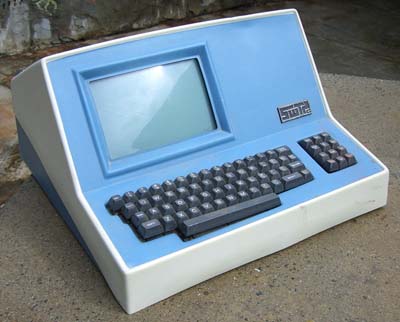 Photo by Bruce Damer
Photo by Bruce Damer| Introduced November 1978, this description is from a
SWTPC catalog. Until recently all terminal functions were designed with hardware logic. A relatively simple terminal with limited functions could easily require as many as sixty or more integrated circuits. More sophisticated terminals with a moderate amount of intelligence could easily have over a hundred IC's. All this has now changed. With the introduction of MOS video controller circuits it has become possible to design a terminal using a controller and a microprocessor that will perform almost any imaginable function with software. The CT-82 has one hundred twenty-eight separate functions-all of which are software driven. It contains fewer parts than most "dumb" terminals. The normal screen format is 16 lines (20 lines selectable) with 82 characters per line. This is an upper-lower case display with a 7 x 12 dot matrix. The high resolution characters are displayed on a Motorola Data Products M-2000 series monitor with a green P-31 phosphor. This monitor has a 12 MHz video bandwidth and dynamic focus circuits to insure a crisp well focused display over the entire face of the tube. An alternate all capital letter format is available (optional) with 16, 20 or 22 lines and 92 characters per line. The lower case portion of this character set has graphic symbols. In this mode the lines may be moved together to give a solid figure or line. Direct cursor addressing combined with the plotting capability makes it possible to indicate the end points of a line and then to automatically draw a line between them. Both the control ROM and the character generator have sockets provided for alternate material in the form of an EPROM. This makes it possible to have special terminal functions, or character sets that can be switched in under computer control. The CT-82 has its own internal editing function. This allows inserting and deleting lines and characters, erasing quadrants or lines; doing rolls, scrolls, slides and other similar functions. The CT-82 can block transmit completed material to the computer, or output material to its own remote printer through the built-in parallel printer I/O port. The terminal can be programmed to operate at any system baud rate that is normally used from 50 to 38,400. The baud rate may be changed at any time within this range with a software command. The cursor position, type of cursor, cursor ON-OFF and blinking are all provided. A command is provided to print control characters and also turn on and off a tape punch or tape reader. Protected fields, shift inversion, dual intensity and many other miscellaneous features make the CT-82 one of the most flexible terminals available. A fifty-six key alphanumeric keyboard plus a twelve key cursor pad is standard. A numeric pad may be substituted for the cursor pad (optional). Connection to the terminal is through a standard DB-25 connector and RS-232 signal levels. The CT-82 operates from 100, 115, 220, or 240 VAC at 50 to 60 Hz. It weighs 20 Ibs, and is a compact 18 wide, 10 high and 18 inches deep. CT-82 Intelligent Terminal, assembled and tested .... $795.00 F.O.B. San Antonio |
CT-82 Users Guide (scanned PDF 6MB)